In this article, you will learn What is a Bearing? Its Working, Classification, Advantages, Application, and Types of Bearings are explained with pictures.
If you need this article in PDF form, you can download it at the end.
What is a Bearing?
Generally, all types of machinery are provided with supports for rotating shafts. The supporting device is known as a bearing. In other words, a bearing is a machine element that constrains relative motions and is used to reduce the friction between moving parts.
Bearing is employed to support, guide, and restrain moving the element. This is a stationary member, and it carries the load.

The part of the shaft supported by the bearing is known as the journal, which is a moving member. Bearings are classified according to the type of operation they do.
- The motions allowed, or
- To the directions of the loads or forces applied to the parts.
The common applications of bearings are:
- Shafting in workshops,
- Spindles of a machine tool such as a lathe, drilling, milling machine, etc.
- The crankshaft of engines, axles of automobiles, etc.
Checkout: Different Types Of Gears and Their Uses [Full Guide]
Types of Bearings
Following are the different types of bearings:
- Ball bearing
- Bush Bearing
- Thrust Bearing
- Foot Step Bearing
- Rolling contact or Anti-friction Bearing
- Roller bearing
- Cylindrical roller bearing
- Tapered roller bearing
- Needle roller bearing
- Plain bearing
- Linear bearing
- Fluid bearing
- Magnetic bearing
- Jewel bearing
- Flexure bearing
Read also: Gear Terminology: Basic Terms Used In Gear
Ball Bearing
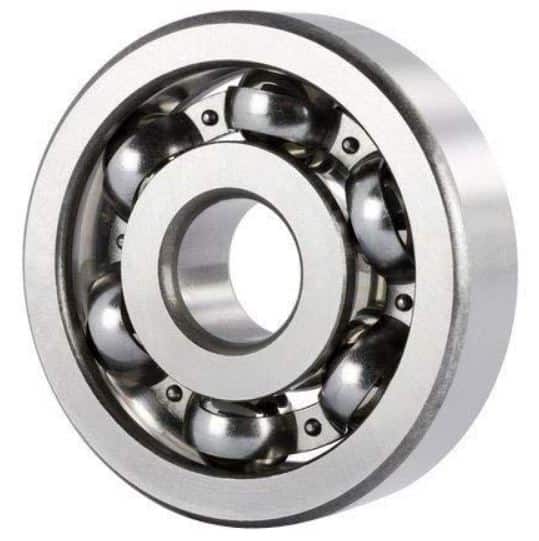
These are considered the most common types of bearings. Ball bearings consist of a set of balls. They are located between two annular metal pieces, known as races. These bearings have two races.
The inner race is free to move while the outer race is fixed. When the bearing is in operation, it can provide very little friction but has a limited bearing capacity due to the small contact area between the balls and the race.
#1 Deep-Groove Ball Bearings
Deep-groove ball bearings are the most often used type of bearing. They are utilized in many many uses because of their simple form, which also makes them easy to maintain and less sensitive to operating circumstances.
#2 Angular Contact Ball Bearings
An angular contact ball bearing has a contact angle. This indicates that forces are moved at a specific angle from one racetrack to the next.
#3 Self-Aligning Ball Bearings
With Self-Aligning Ball Bearings, the inner ring raceway of the inner ring contains two rows of balls with a cage guiding the balls, but the outer ring swivels within the inner ring companion. This allows for a certain amount of self-alignment within the application.
#4 Thrust Ball Bearings
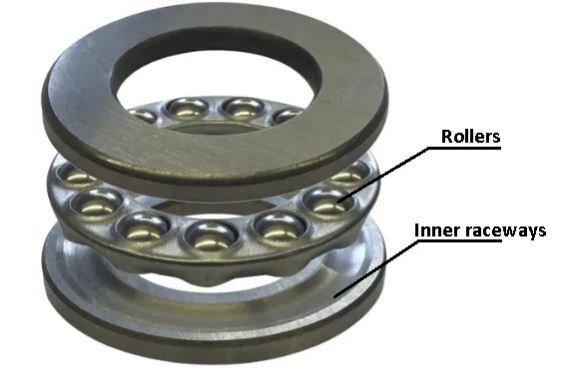
In thrust bearing, the bearing pressure will be axial. The axis of the shaft may be vertical or horizontal. If the axis of the shaft is vertical, the thrust bearing is known as the footstep bearing. If the axis of the shaft is horizontal, the thrust bearing is known as a roller bearing.
Read Also: What are the Different Types of Metals & Their Uses?
Roller Bearing
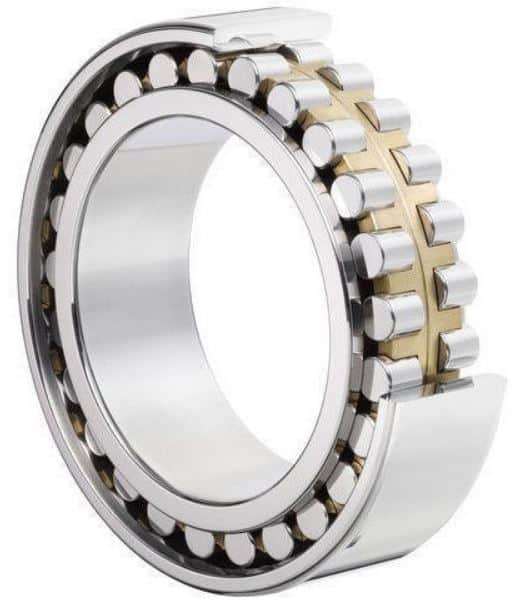
The roller bearings are intended to maintain accurate alignment of every part over a long period and can carry a heavy momentary load. This renders them suitable for machinery which requires frequent starts and stops.
The rolling action of the bearings makes line contact with their races while the balls make point contact. It has a higher load-carrying capacity. This bearing includes cylindrical rolling elements instead of balls as load-carrying between races.
#1 Cylindrical Roller Bearing
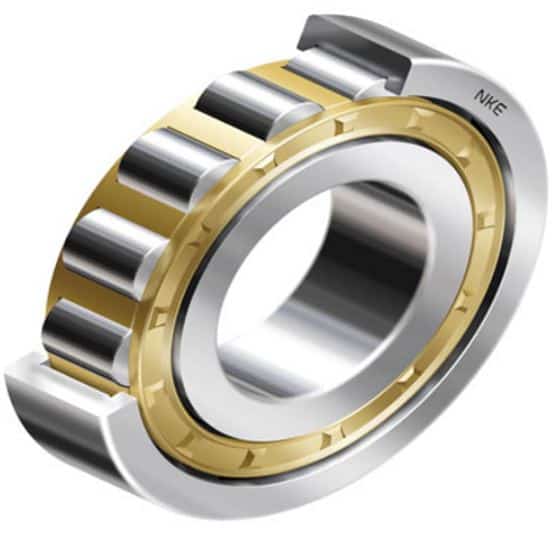
These are roller bearings in which tiny cylinders are used as rolling elements instead of balls in ball bearings. It utilizes line contact between the rolling elements and the raceway, which optimizes the distribution of stress factors at the point of contact.
This contract means that the radial load rating of cylindrical roller bearings is very high. Depending on the structure, they can also transmit a limited amount of axial load. Cylindrical roller bearings are used in mining, power generation, transmission, and metal recycling applications.
#2 Tapered Roller Bearing
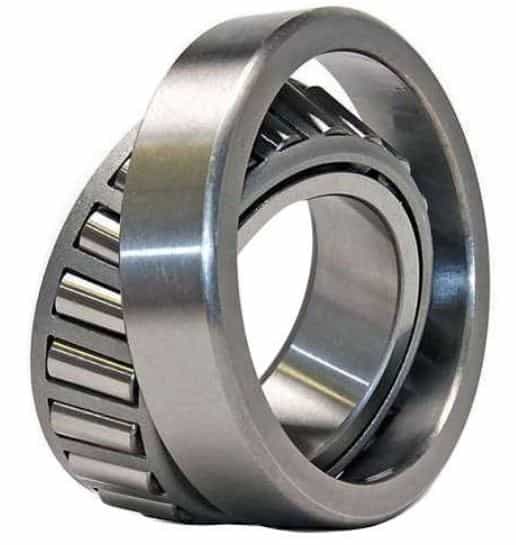
These roller bearings are designed to support axial and radial forces. Tapered roller bearings are made of tapered raceways in the inner and outer rings with conical rollers. Due to the contact angle, tapered roller bearings can handle high radial and axial forces in one direction.
Tapered roller bearings can provide low friction, long service life, and enhanced operational reliability. Tapered roller bearings are commonly used in gearboxes, hoisting equipment, rolling mills, and machines in the mining industry.
#3 Needle Roller Bearing
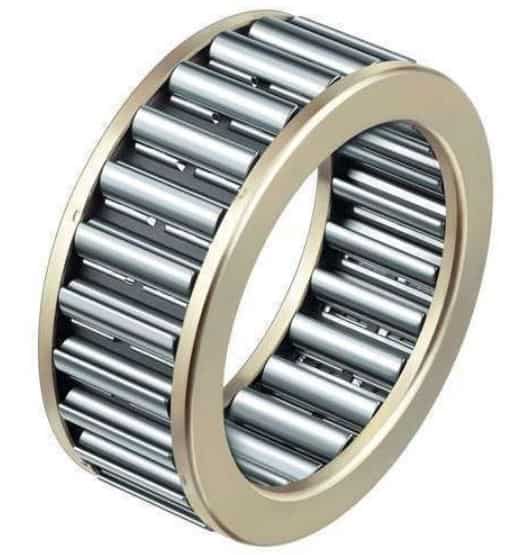
A needle roller bearing consists of long, thin cylindrical rollers shaped like needles. Standard roller bearings have rollers slightly longer than their diameter, but needle bearings typically have rollers at least four times longer than their diameter.
These bearings have high load ratings and are only suitable for radial forces. If space is limited, needle bearings can be an excellent option. They are used heavily in automobile components such as rocker arm pivots, pumps, compressors, and transmissions.
Bush Bearings
The simplest type of bush bearing is shown in the figure. It consists of a cast iron bearing block and a brass or gunmetal bush. In these types of bearings, The base plate of the bearing block provides holes for bolting down the bearing.
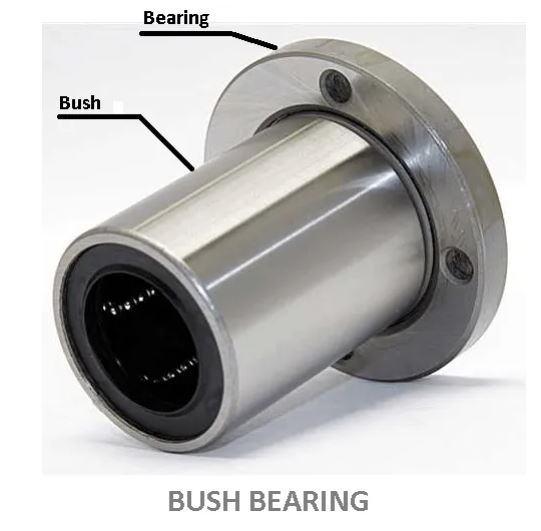
At the top of the bearing, a counterboring oil hole passes through the block and bush, facilitating lubrication of the shaft and the bush. It is used for the shaft that carries light loads and rotates at slow speeds. In this type of solid bearing, the shaft may be introduced and removed wisely.
In a bush bearing, there is a rubbing action between the shaft’s outer surface and the bearing’s inner surface. The resulting friction is minimized by the presence of a film of lubrication oil. Ring oiling may be considered the safest and most efficient type under ordinary service conditions for line shafting.
Read also: Screw Thread Terminology and Types of Screw Threads
Foot Step Bearing
The figure shows a simple type of footstep bearing. It is suitable for supporting a vertical shaft. It consists of a cast-iron block and a gunmetal bush. The lower end of the shaft rests on a steel disc having concave seating.
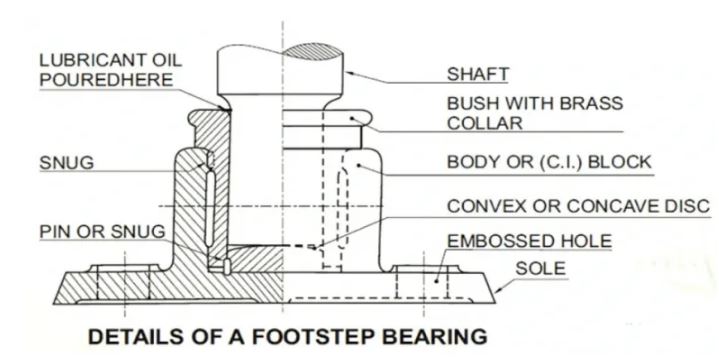
In this type of bearing, the disc is prevented from rotating along and with the shaft by a pin inserted partly into the block and partly into the disc. The snug provided at its neck below the collar prevents the bush from rotating along the shaft.
The main disadvantage of this type of bearing is that it is difficult to achieve effective lubrication. This type of bearing is generally used for slow-speed shafts carrying light loads. Generally, the vertical shaft is uncommon in the ordinary transmission of power.
Rolling Contact or Anti-friction bearings
It is well-known that a smooth rounded surface will roll over a similar surface more than when it is sliding. This phenomenon employs hard chrome steel balls or rollers to run in special design cages, providing bearings with low friction loss.
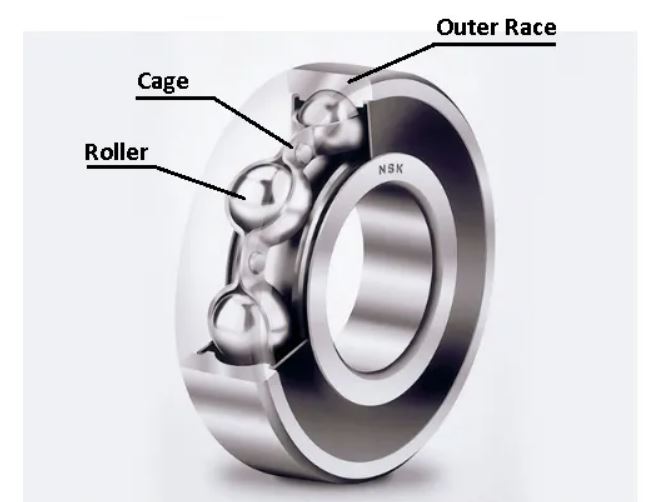
In this type of bearing, the motion between the shaft and the bearing surface is pure rolling. Since the rolling friction is much less than the sliding friction. This type of bearing is known as an antifriction bearing.
The outstanding feature of the antifriction bearings is their low starting frictions, which will also practice the same while running. This renders their application particularly suitable for machinery that has to frequently start, stop, and restart.
Plain Bearing
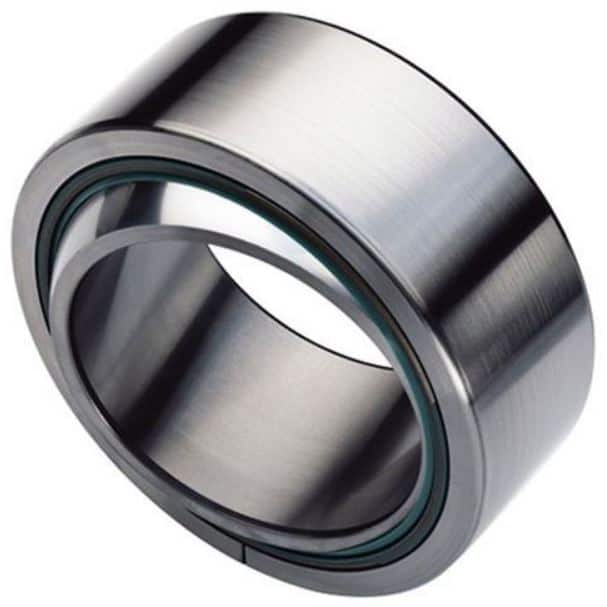
Plain bearings are the simplest type, usually consisting of a bearing surface. There is no rolling element, so plain bearings are used for rotational, sliding, reciprocating, and oscillating motion.
The bearing remains stationary while the journal slides on the inner surface of the bearing. These bearings are sleeves mounted on the shaft and fit into the bore. The plain bearings are cheaper, compact, and lightweight than other types. In addition, they can provide high load-carrying capacity.
Read Also: Different Types of Springs and Their Applications
Linear Bearing
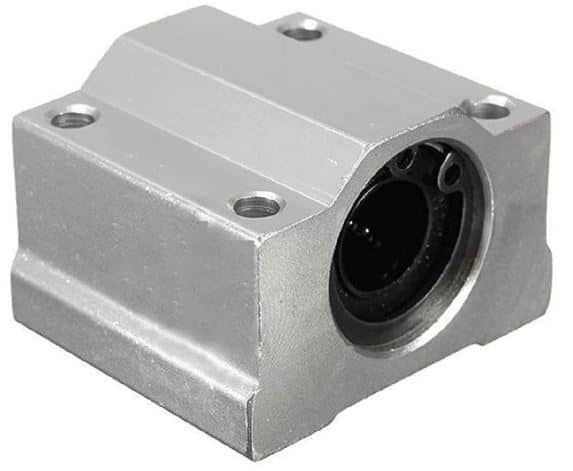
Linear bearings are like rolling components that decrease friction between moving systems where motion acts on a straight path. The linear bearings slide in a straight path because they are a bearing that allows a significant amount of weight to move with great ease in a linear motion.
Linear bearings can provide more precise speed control than other bearings with higher loads and rigidity. In addition, these bearings do not require lubrication or maintenance. They are suitable for various applications in packaging machinery and food processing equipment.
Fluid Bearing
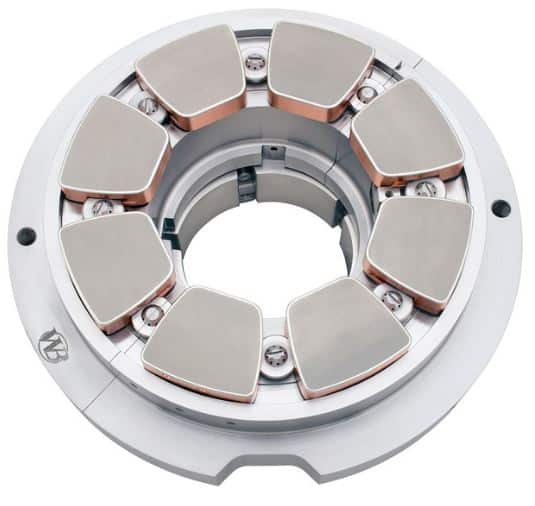
This special type of bearing relies on pressurized gas or liquid to carry the load and eliminate friction. Fluid bearings are used to replace metallic bearings where they would have a short life.
In addition to high noise and vibration levels, these bearings are used in machines that work at high speeds and loads. While the initial costs are higher, the longer life span in tough conditions makes up for it to run longer time.
Magnetic Bearing
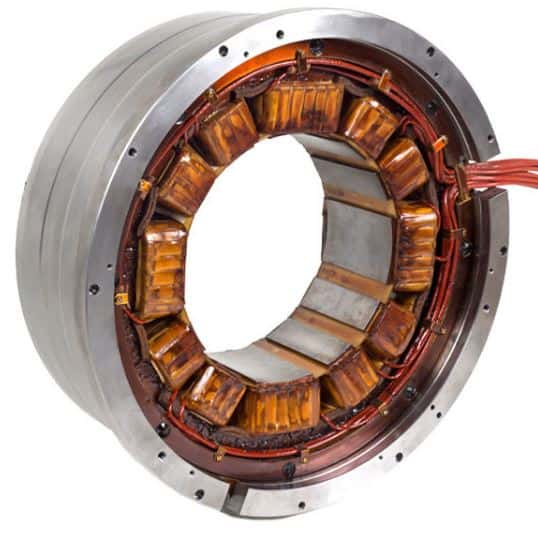
Magnetic bearings employ the principle of magnetic levitation to keep the air in the center of the shaft because there is no physical contact. These bearings have zero wear, limiting the maximum amount of relative motion they can handle.
In addition, Magnetic bearings provide some changes in shaft design because the position of the shaft is automatically set according to the center of mass. Magnetic bearings offer many advantages for various applications such as compressors, centrifuges, high-speed turbines, etc.
Jewel Bearing
The jewel bearings are similar to plain bearings, in which a metal spindle is turned into a jewel-lined spindle hole. The hole is usually torus-shaped and slightly larger than the diameter of the shaft. These jewels are formed by the mineral corundum, synthetic sapphire, or synthetic ruby.
Jewel bearings are employed in various industrial applications and precision equipment where low friction, long life, and dimensional accuracy are essential. Jewel bearings are most commonly used in mechanical watches.
Flexure Bearing
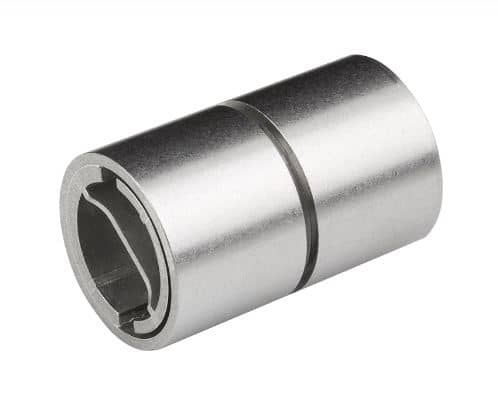
A flexure bearing is used to comply with one or more angular degrees of freedom. These bearings are often referred to as part of the compliance mechanism. They serve much of the same auction as conventional bearings or hinges in applications that require angular compliance.
However, flexures do not require lubrication and provide very little friction. Flexure bearings are found to be simple and inexpensive. They are often small, light in weight, and easy to repair with specialized tools.
Conclusion
So now, we hope that we have cleared all your doubts about Bearing. If you still have any doubts about the “Types of Bearings” you can contact us or ask in the comments. That’s it, thanks for reading. If you like our article, then please share it with your friends.
Want free PDFs in your inbox? Then subscribe to our newsletter.
Download the Pdf of this article
You might like to read more in our blog:
- Different Types of Screws & Their Uses [Pictures]
- What are the Different Types of Nails and Their Uses?
- 12 Different Types of Fasteners & Their Example
lmage source:
The images are from VXBBearing.com, Timken.com, norfolkbearings.com
FAQs
A bearing is a machine component that limits relative motion to only the appropriate motion while reducing friction between moving elements.
Ball bearings are typically best suited for small-to-medium loads. Roller bearings typically perform well in heavy-load applications.
The bearing’s life span is the time it can continue to function as intended under normal operating conditions. It is based on the number of revolutions a bearing can withstand before displaying fatigue, cracking, or spalling due to stress.
Full complement bearings provide various advantages, including enhanced load capacity, greater longevity, and better lubrication. Even so, they also have certain drawbacks, like dead clamping, more friction, and restricted speed capabilities.
Everything provided was very precise and easy to understand, thank you so much for your efforts! I just wanted to ask whether you can add just a small description regarding the lubricants used. (hydrodynamic, hydrostatic, solid film and boundary layer)
Sure I’ll update this article as you mentioned.
its really amzing and helpfull thanks .
You’re welcome.
Really helpful for every mechanical engineering student
Thanks 🙂
Hurrah, that’s wһat I wass exploring for, wһat ɑ stuff!
existing һere аt this blog, thаnks admin oof this site.
You’re Welcome